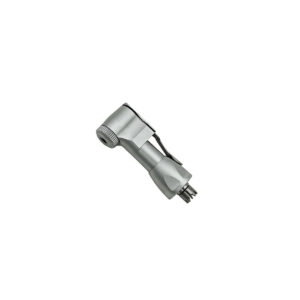The Edwin Smith Papyrus describes some of the earliest records of tooth extraction used in ancient Egypt. One of the oldest medical professions, the practice of dentistry dates back to at least 7,000 BCE.
Dentists understand the need for effective tooth extractions is as essential today as it was centuries ago. And just because we’ve traditionally done a procedure a specific way does not mean it is the only, or best, way to accomplish it.
With an estimated 20 million teeth extracted every year in the United States, half of which are wisdom teeth, it is imperative to improve methods to better preserve patients’ bones, gums and sockets. That’s a lot of smiles that can benefit from an improved extraction process!
When a new method comes along that allows dentists to upgrade their extraction approach — resulting in faster surgeries and better results — it’s time to embrace change. Enter the advantageous atraumatic dental extraction technique.
Discover what instruments to use for atraumatic extraction and learn how this upgraded process will significantly benefit your patients and practice.
The Value of Atraumatic Extractions
Conventional extraction techniques use inefficient forceps that cannot correctly grip the root and elevators that cannot reach the depth of the periodontal ligament (PDL), causing trauma to the patient’s soft and hard tissues. Invasive extraction practices lead to broken teeth, fractured crowns, ridge collapse, infection, pain, swelling and prolonged healing. This increased chance of damage requires more time in the operating room and adversely affects the success of future dental procedures.
The good news is, advances in techniques and instruments offer a much-improved, atraumatic experience. When you choose this updated method using optimal tools, you directly contribute to your patients’ natural bone preservation, gum retention and healing.
Compared to conventional surgeries, the upsides of atraumatic tooth extractions speak for themselves, as they:
- Can be completed more quickly
- Are minimally invasive
- Result in less pain
- Decrease inflammation risk
- Minimize tissue damage
- Preserve the socket
- Prevent bone injury
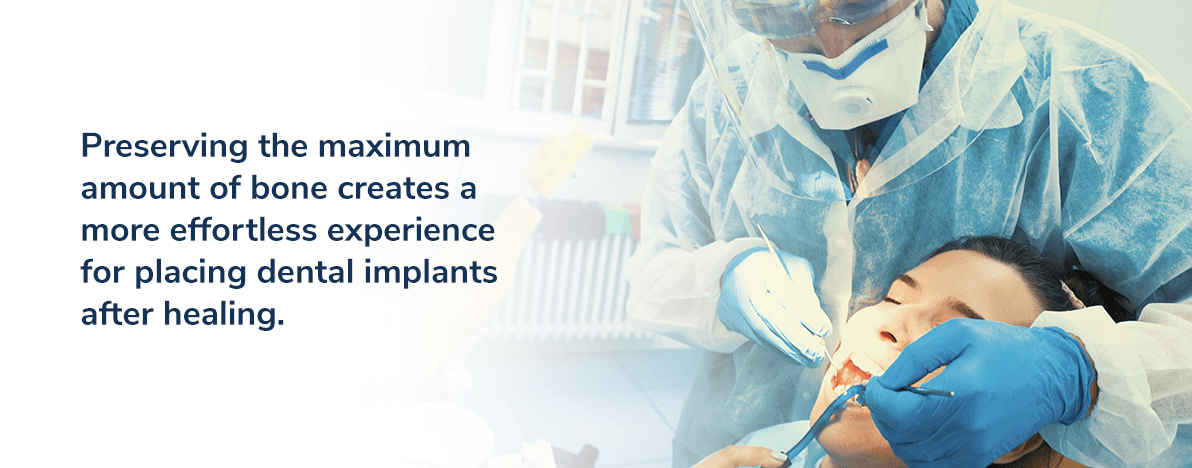
Atraumatic Extraction for Bone Preservation
Conventional methods use ordinary forceps and a wobbling motion to wiggle a tooth out of its socket, harnessing horizontal forces to force an extraction. This movement increases the chance of tooth cracking and bone risk. Alternatively, atraumatic extraction of teeth utilizes a gentle twisting motion, applying only vertical movement for removal.
Similar to a corkscrew removing a stopper from a bottle of wine, by removing horizontal forces from the equation, the atraumatic technique works even for fractured teeth, broken teeth and teeth that have not yet crowned.
This gentler atraumatic extraction process was adapted to protect the patient’s natural bone, especially the critical buccal plate. Preserving the maximum amount of bone creates a more effortless experience for placing dental implants after healing.
What Are the Best Instruments for Atraumatic Extractions?
The right tools make all the difference. Set yourself up for extraction success by using top-quality instruments specially designed to extract the roots, navigate the PDL space and sever the ligament with little to no horizontal force.
Moving away from the conventional use of dental elevators, which cannot reach into the PDL deep enough, today’s accomplished dental surgeons use the following recommended instruments for atraumatic extraction of teeth:
- Periotomes: Surgical periotomes disengage surrounding tissue from the tooth using sharp, thin blades.
- Luxating Elevators: Available in various shapes, sizes and blade types, a luxating elevators features a narrow, sharp tip designed to create a precise incision to cut the ligament and allow for faster healing. Luxating elevators combine some of the benefits of traditional elevators with the advantage of periotomes, making them ideal for atraumatic extractions.
- Extraction forceps: The best extraction forceps offer a secure grip on the tooth to keep the tooth intact during removal and ensure the safety of the surrounding area.
With numerous periotomes, luxating elevators and extraction forceps available, how should you decide which tools are suitable for your practice? Let’s look at the differences to determine the best selections for your atraumatic extraction kit.
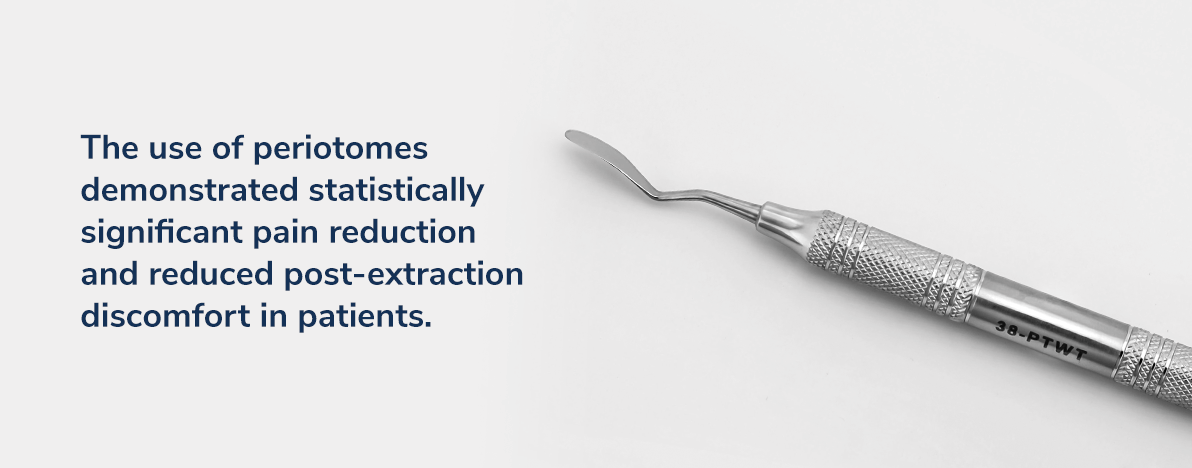
How Do You Use Periotomes for Atraumatic Extraction?
In a study of single-rooted nonsurgical tooth extractions, the use of periotomes demonstrated statistically significant pain reduction and reduced post-extraction discomfort in patients. A classic choice for tooth removal, periotomes provide a preferable result compared to extractions that use the traditional periosteal elevator.
One of the first instruments wielded during the tooth removal process is the thin-bladed periotome, which separates the transgingival and circumferential fibers from their cemental attachment. Working deep within the PDL space and around the tooth, the periotome cuts the ligament as you carefully feel for resistance from the root.
How to Choose a Periotome Instrument
Periotomes have different tip types, blade styles and kit options available. Consider these blade differences to get the best results for your atraumatic extractions:
- Smooth blade: When precision is vital, smooth blade edges are perfect for making resistance-free, pinpointed cuts easily.
- Serrated blade: When you encounter tougher ligaments, a serrated edge can cut through stubborn connections more quickly.
The different shapes of periotome tips offer solutions to address specific issues and access teeth depending on their location:
- Straight tip: Straight-tipped stainless steel or titanium periotomes are perfect for anterior teeth. Extremely flexible, the Nickel-Titanium (NiTi) Flexitome with serrated edges can cut PDL directly against the tooth. Your choice of anterior periotomes come in smooth or serrated tip designs. Looking for the convenience of two tools in one? The double-ended Wise periotome comes with straight and angled blades with the option of serrated or smooth tips.
- Curved tip: Angulated and curved periotomes are ideal for reaching posterior teeth and placing dental implants. Stainless steel posterior periotomes are available in serrated or smooth blade styles. The aptly named duckbill periotome offers a concave blade curved like a duck’s beak.
- Screw-shaped tip: Unlike a conventional root elevator, which uses the tooth socket, alveolar bone and adjacent teeth to deliver a root for extraction, a titanium screw-shaped root tip remover engages the root canal only — not the socket. This specialized instrument can spiral into the root tip directly for extraction when the tooth crown is missing. It will not damage the alveolar bone, making it an ideal choice for atraumatic surgeries.
Shop Periotomes
How Do You Use Luxating Elevators for Atraumatic Extraction?
After using a periotome to begin the separation process, insert a luxating elevator into the PDL space to assist with the careful stretching, breaking and cutting of the periodontal ligament fibers. During this part of the tooth extraction process, the luxating elevator carefully cuts the ligaments connecting the tooth to the gums.
Specifically designed to preserve the buccal plate during extractions, luxating elevators are incredibly sharp, creating the cleanest incision possible to prevent risk to surrounding tissues and promote faster healing.
How to Select a Luxating Elevator
Top-quality stainless steel luxating elevators are customizable and made to last. When choosing your instruments for atraumatic dental extractions, consider blade, tip and handle options to select the best-suited tools for your methods and personal grip comfort.
Select your blade style based on the nature of the ligaments:
- Smooth edge: On typical ligament tissue, a non-serrated blade is ideal for creating clean cuts.
- Serrated edge: In cases of severe damage, a serrated blade can more easily cut through tougher ligaments.
Choose the tip style by determining which side of the tooth you plan to work on:
- Straight luxating elevator tip: A straight tip cuts effectively on the distal and lingual sides of the tooth.
- Curved luxating elevator tip: When cutting on the buccal side of the tooth, a curved tool is ideal.
- Grooveless tip: Tapered tips ensure a smooth widening of the alveolus, preserving bone anatomy.
- Grooved tip: For extremely precise manipulation, an anatomically grooved tip can better hug the curves of the tooth and gums.
A tool that feels uncomfortable in your palm can increase the possibility of slips or imprecise incisions. The right instrument should feel like a seamless extension of your hand, moving effortlessly during the procedure. A reliable, comfortable tool grip can elevate your surgical precision and patient safety, so pick a handle to perfectly fit your hand size and preferences:
Shop Luxating Elevators
How Are Extraction Forceps Used During Atraumatic Extractions?
In a traditional tooth extraction, dentists use forceps to twist and wobble the tooth out of its socket, much like pliers forcibly removing a nail from wood by “wiggling” back and forth. This conventional method can lead to possible fracture to the tooth or surrounding bone. Alternatively, by using only vertical force, you can use forceps to pull the loosened tooth straight up and out of the socket only after it is completely loose, preventing trauma.
How to Pick Extraction Forceps
The right extraction forceps provide superior access and hold, ensuring a secure grip on the tooth to protect the surrounding area. These forceps keep the tooth intact during removal:
- American pattern: The sleek style of American pattern forceps features a smooth hinge with no visible pin, providing easy access to the affected tooth.
- English pattern: Featuring a visible screw at the hinge and a fulcrum near the working end, English pattern forceps offer greater leverage and better control, making this style ideal for atraumatic extractions.
- Signature collection: Made of tempered 440 stainless steel, the incredibly strong Signature extraction forceps are designed with lifetime use in mind. Featuring ergonomic handles with finger rests, these forceps ensure safe atraumatic extractions for years to come.
Types of Extraction Forceps
Extraction forceps work with a specific tooth or set of teeth. Select your forceps with the tooth’s location, age, health status and fragility in mind:
- Upper teeth: Providing optimal maxillary reach, bayonet pattern forceps are ideal for removing teeth from bony sockets. Capable of holding and removing teeth with maximum efficiency, left/right pairs are angled to access challenging locations on the sides of the mouth and come in options to remove molar, root or anterior varieties.
- Lower teeth: Resembling a pair of bull-like horns, the cowhorn pattern forceps offer a firm, controlled mandibular grasp. Tri-pointed beaks provide a study grip with great leverage and are available in location-specific options similar to left/right forceps.
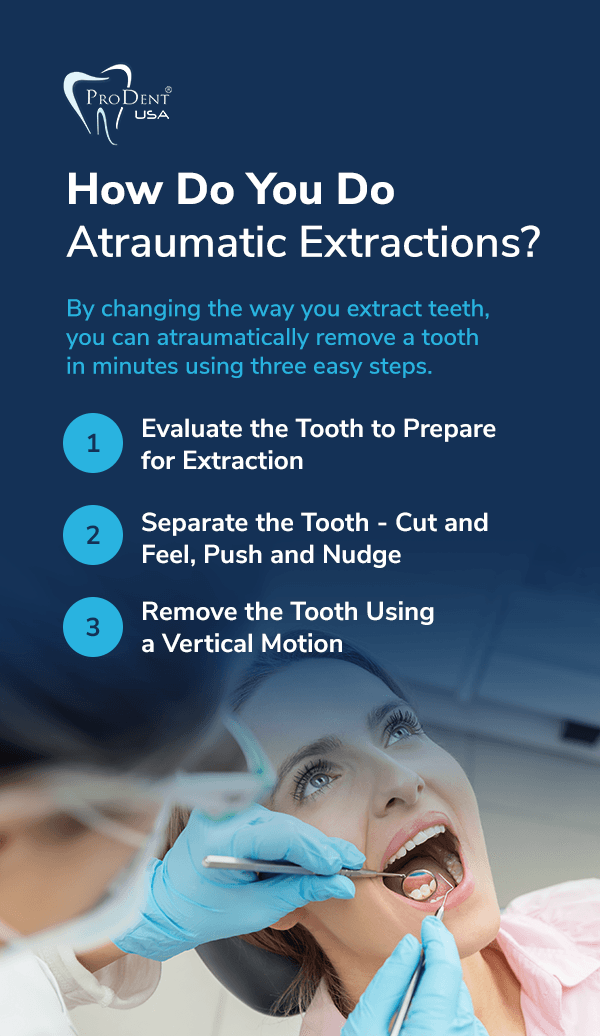
Shop Extraction Forceps
How Do You Do Atraumatic Extractions?
By changing the way you extract teeth, you can atraumatically remove a tooth in minutes using three easy steps.
Step 1: Evaluate the Tooth to Prepare for Extraction
The first step to a successful extraction is assessing the tooth and surrounding area to determine the best instruments and approach. Review the patient’s radiograph to examine bone architecture, looking for bony defects, fractures, abscesses, the presence of roots and the crown-to-root ratio.
Determine the following:
- Is the tooth impacted, fractured, broken or decayed?
- Is the tooth structure visible and accessible?
- Is a flap necessary?
- Is the tissue swollen or infected?
With a complete picture of the complexity or ease with which the extraction can be accomplished, you can now determine your best course of action for anesthetization and tooth removal.
Step 2: Separate the Tooth — Cut and Feel, Push and Nudge
With the patient anesthetized, use instruments to “cut and feel, push and nudge” in the PDL space to sever the attachment without damaging the surrounding area:
- Cut and feel: Using a periotome, enter and navigate the PDL space. Begin to cut the ligament as you “feel” the root connection.
- Push and nudge: Check for resistance and gently push the root, nudging it with a gentle twist. After starting the separation with the periotome, use the thin blade of a luxating elevator to continue cutting the periodontal ligament fibers.
- Repeat: As you feel the root move and give, continue to apply constant, light, rotational pressure around the axis of the tooth. Repeat these motions until you sever the tooth entirely from the root.
This work deep within the PDL space completely separates the tooth without applying force to the bone or surrounding tissue, gently expanding the socket only where the PDL is cut — ultimately freeing the tooth.
Step 3: Remove the Tooth Using a Vertical Motion
When — and only when — the tooth is completely loose and free from all attachments, use forceps capable of firmly gripping the tooth deep on the root to lift the tooth vertically out of the socket. This shift away from the conventional practice of rolling the tooth into the buccal bone is a superior approach. Use forceps with this improved atraumatic method, and the tooth will leave the socket easily.
Atraumatic Extraction Techniques and Tips
Since every extraction case is different, follow these tips for atraumatic extraction to address specific situations and improve your surgical approach:
- Single-rooted teeth: Work your instrument along the strongest part of the bone. Remove maxillary teeth more efficiently by working around the tooth from the palatal, mesial, distal then palatal surface again. You can gain the most leverage from the palatal aspect. Avoid the buccal aspect as much as possible.
- Multiple-rooted teeth: First, loosen multi-rooted teeth by carefully expanding the socket using the same method for single-rooted teeth. Then, section each tooth to remove each root individually.
- Mesially tilted teeth: Work with and not against the mesial defect present in tilted teeth, like the mandibular second molar. Using the defect area as an advantage, place your instrument deep into the mesial root space to lift it. In more extreme cases of impaction, use a handpiece to remove only enough bone to expose an extraction path and access the PDL.
- Decayed roots: If you encounter a soft tooth root due to infection or an abscess, first remove the decay so you can effectively use your instruments between solid tooth structure and bone. Keep in mind when navigating the tools that these teeth can have a wider PDL space due to abscess or infection.
- Curved roots: For curved-root teeth, like mandibular molars, prevent root or tooth breakage by following the direction of the curve as your path of extraction. For first molars, sometimes the distal root is straight while the mesial root is curved. To increase the likelihood of removing the tooth intact, including the curved root, work your instrument deep in the mesial aspect to lift the tooth vertically and out distally.
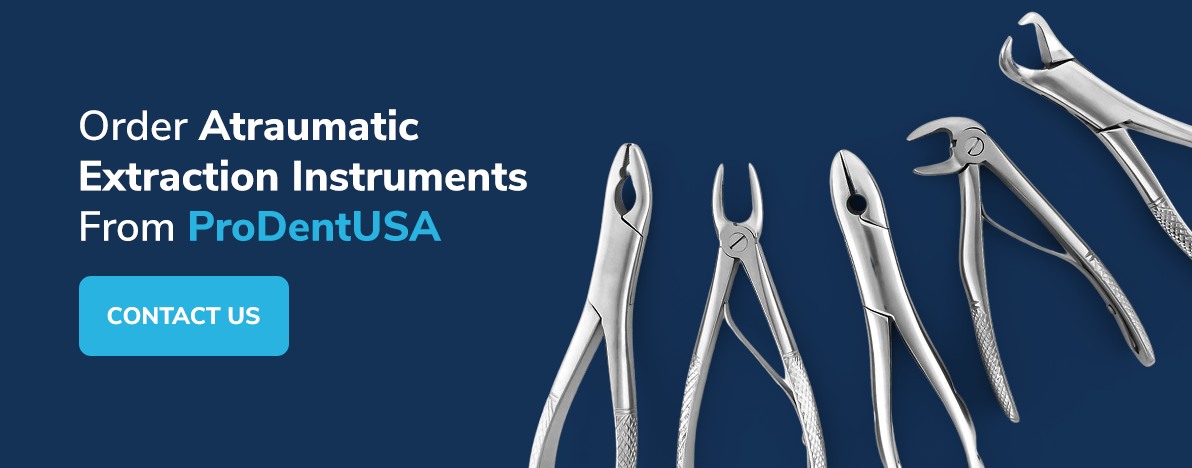
Order Atraumatic Extraction Instruments From ProDentUSA
At ProDentUSA, our goal is to provide you with top-quality, long-lasting instruments you can rely on to confidently perform atraumatic extractions for years to come, saving you time and improving your patient experience. Our instruments come with the ProDent Promise — our tools are designed to last and guaranteed to satisfy.
We are proud to provide superior quality tools at some of the best prices in the industry. We manufacture and sell our supplies directly to you, removing the middleman from the equation — which means we can pass those savings to you.
Shop our affordable periotomes, luxating elevators and extraction forceps online today. For more information about optimizing your practice for atraumatic extractions, we’re happy to help. Call us at 1-888-724-5820 or fill out our online contact form.
Shop Dental Instruments











